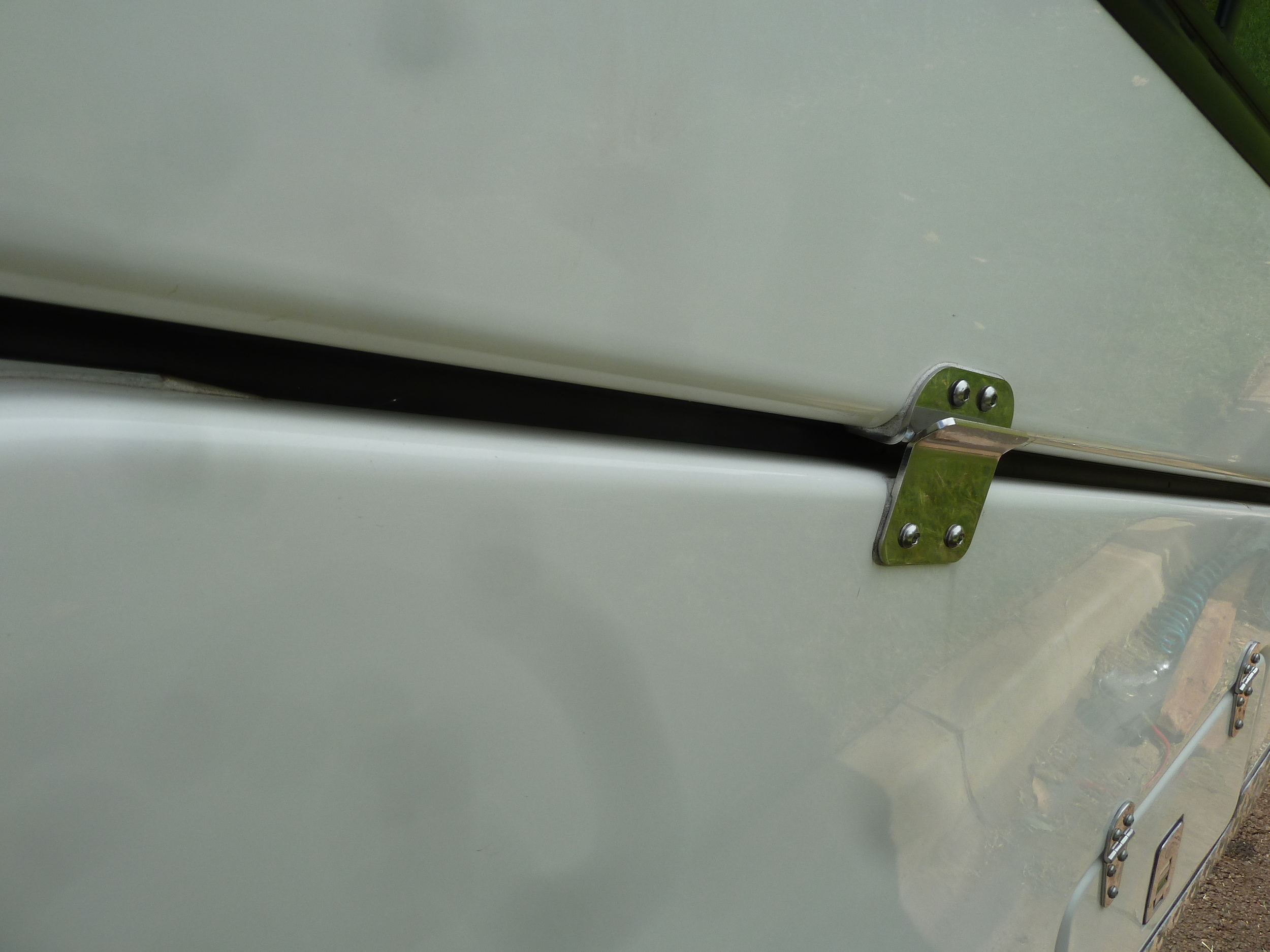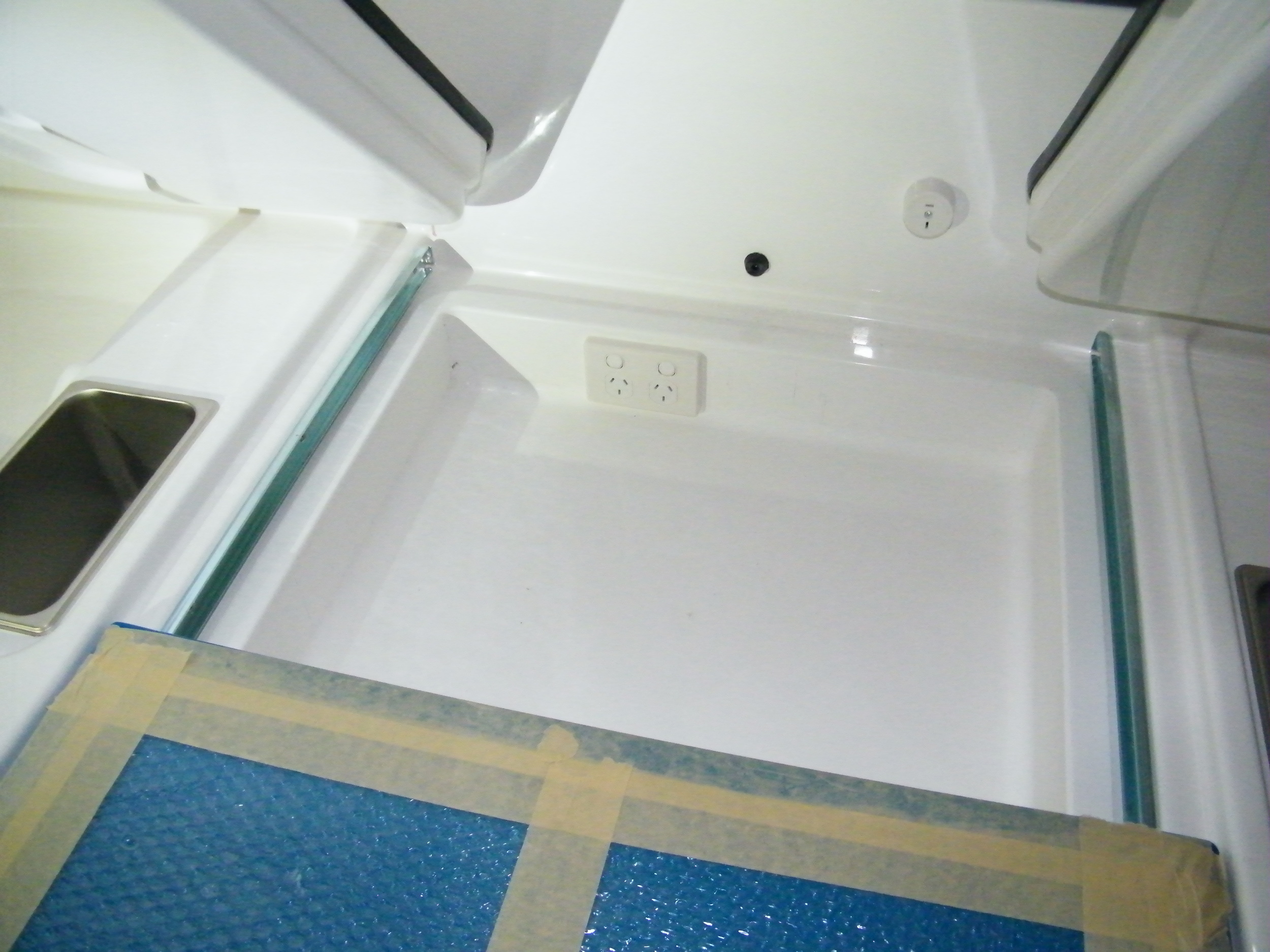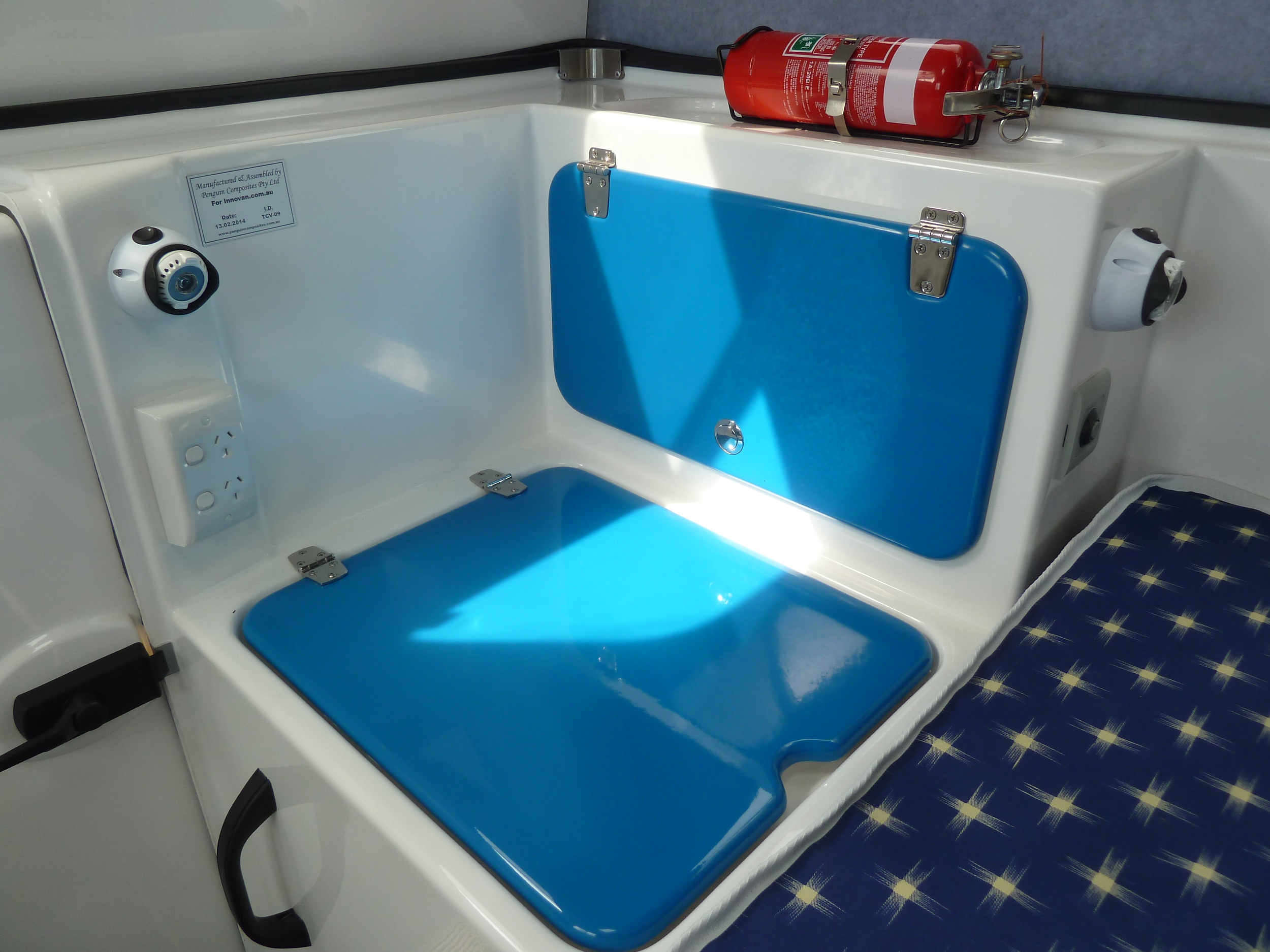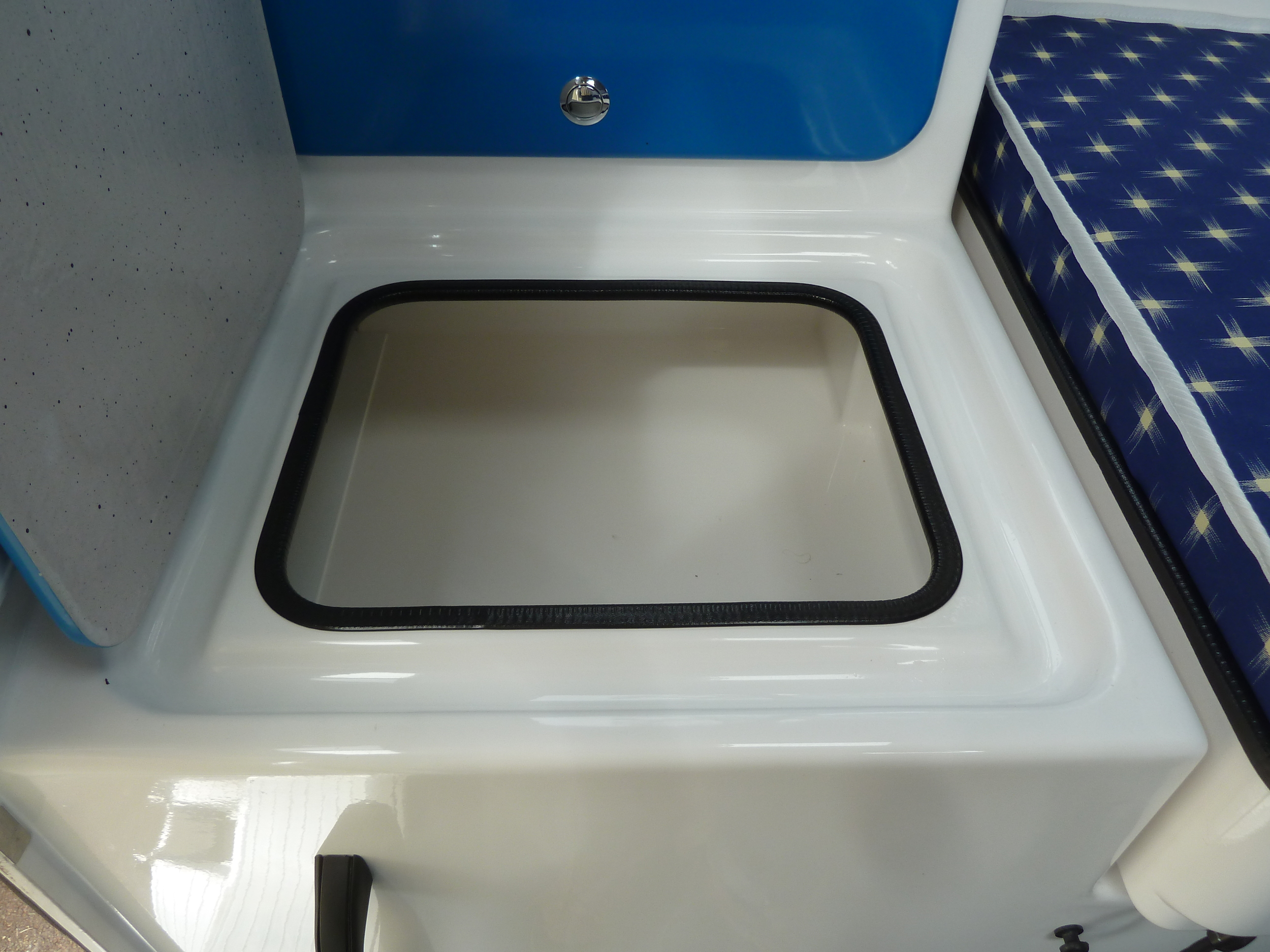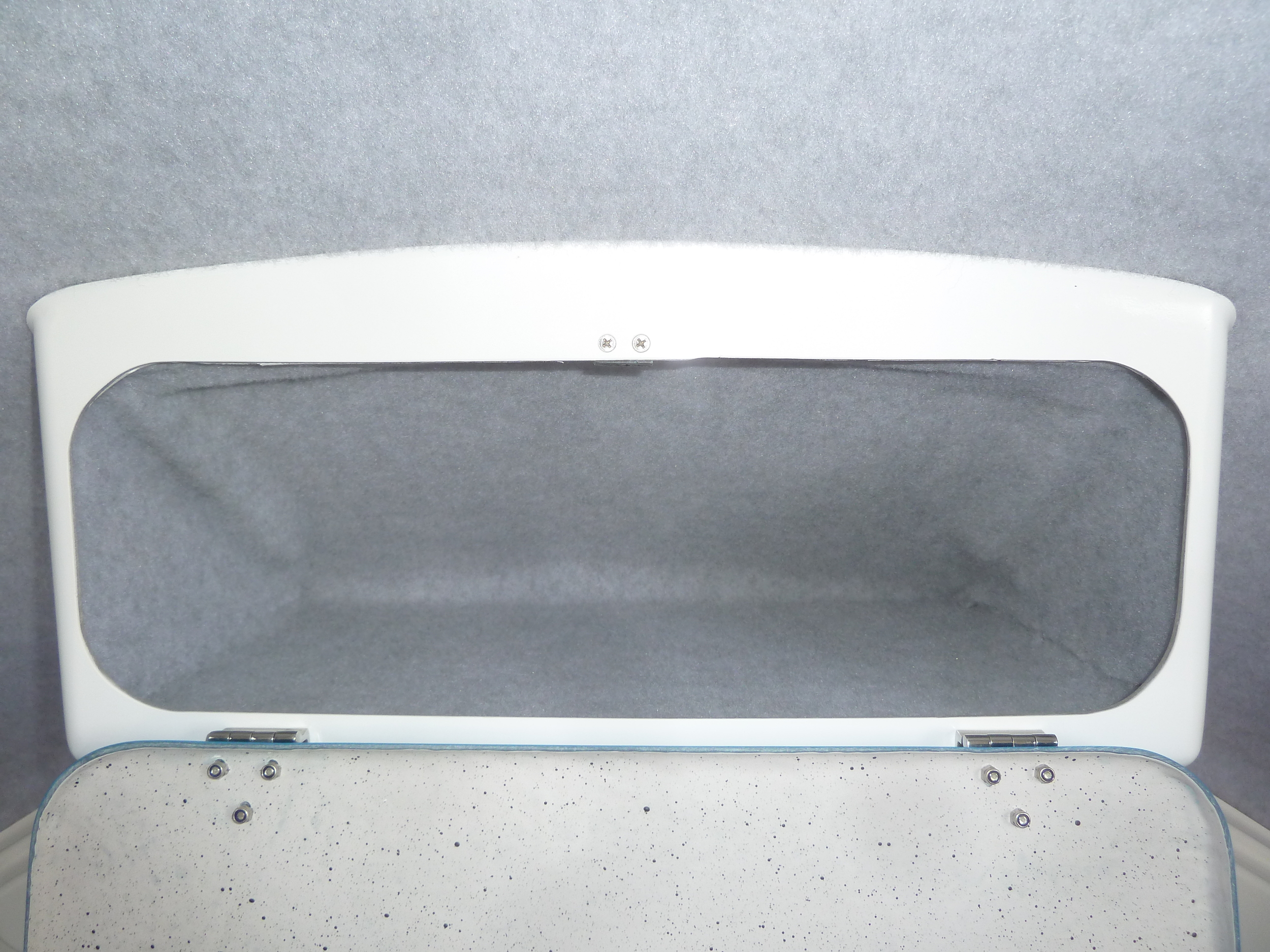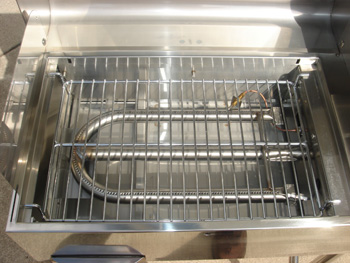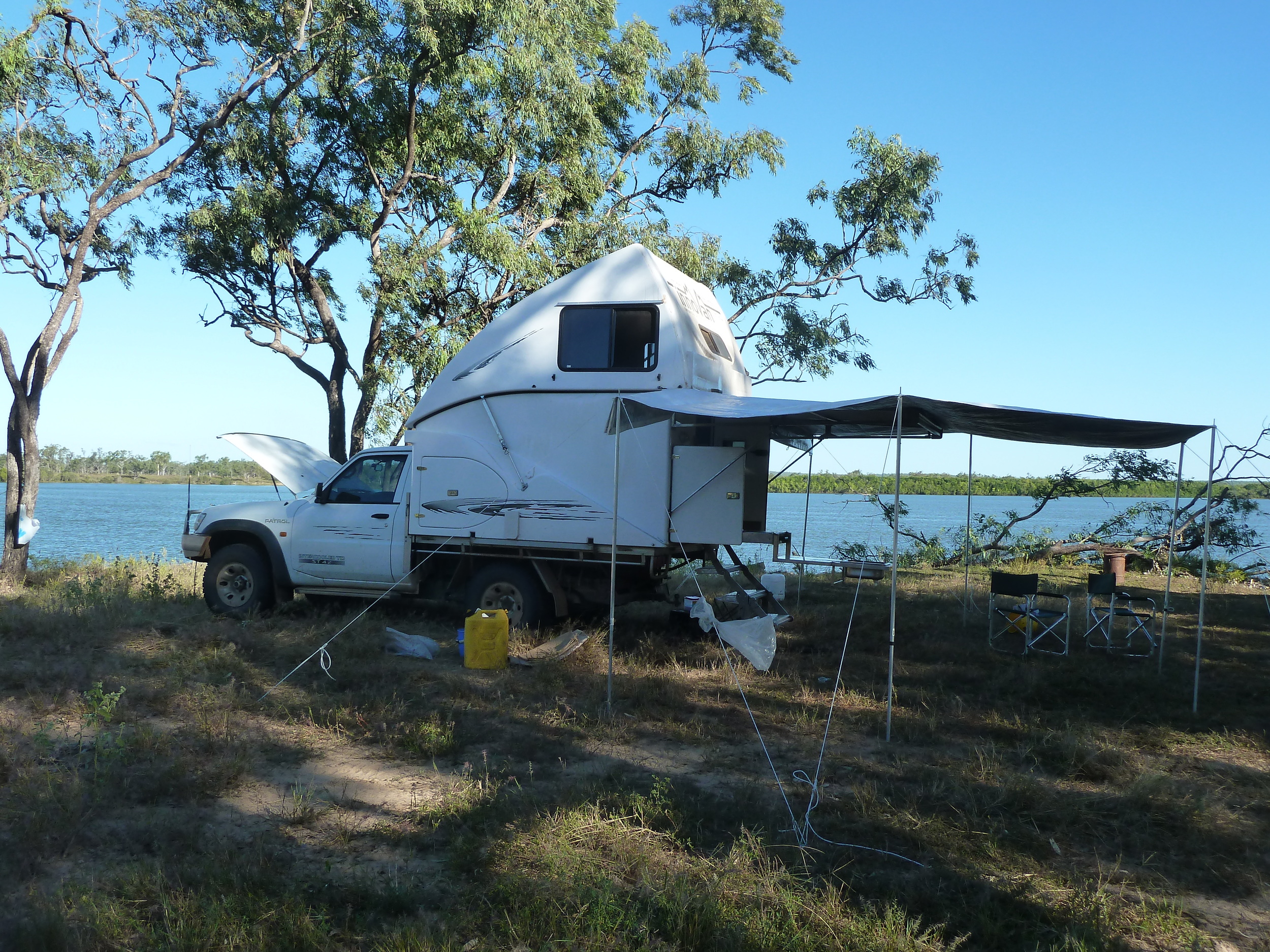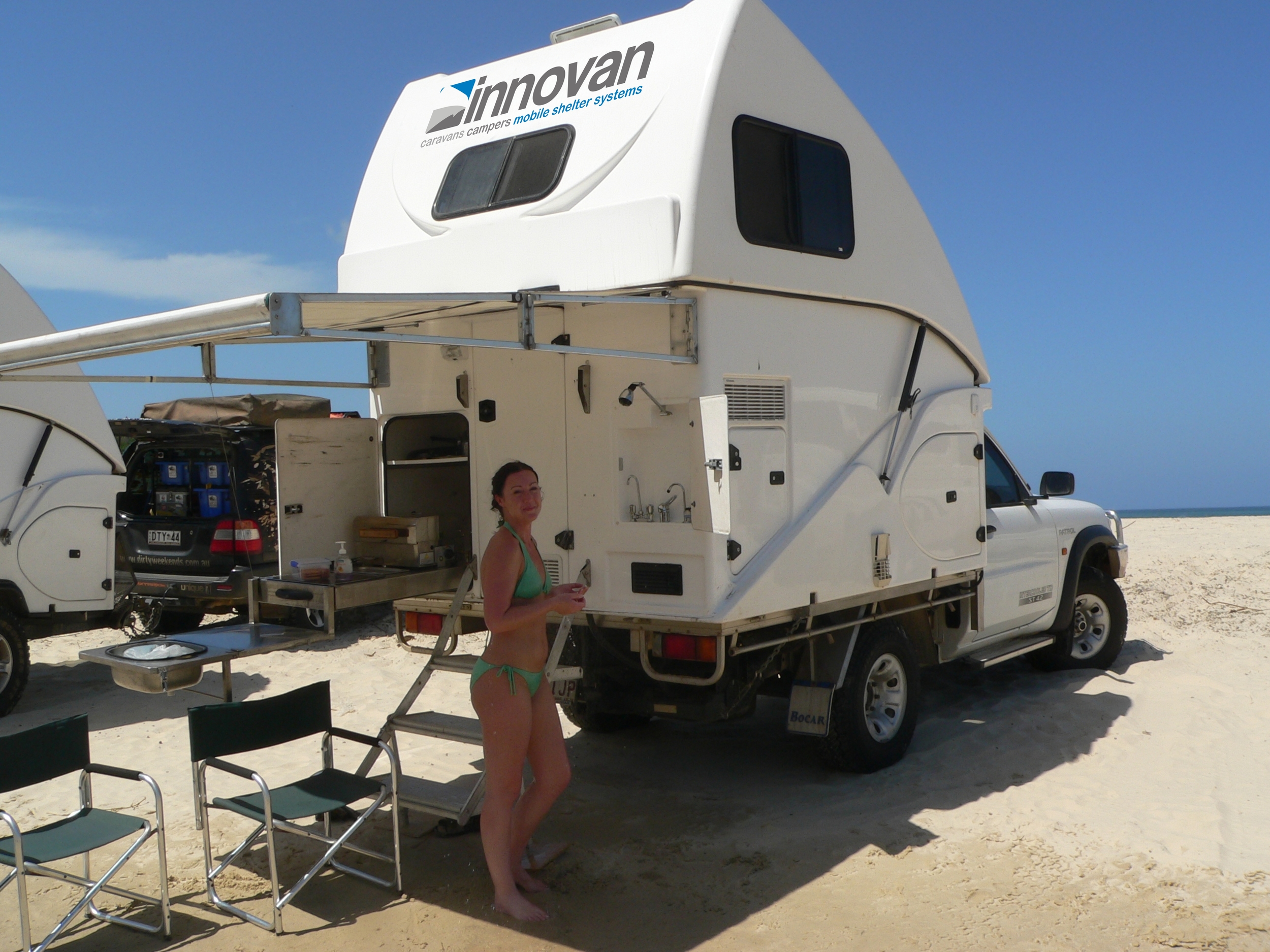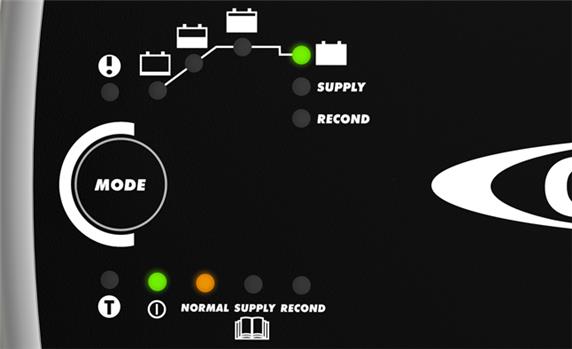The following section provides a detailed review of the major functions and features available with the innovan XS slide on camper. For your convenience we have also linked these descriptions with the feature, function or optional line items found on the Slide On Product Enquiry Form. For example, A1 below refers to the A1 line item outlined within the enquiry form.
Rather than have you flick between website screens and comparing these notes, we have provided you with a printable PDF version. Click the below button and print off these notes to help you with your online enquiry form process.
Section A
A1. The GRP, which is commonly referred to as “fibreglass”, allows strong and comparatively light construction and the ability to provide a smooth, aerodynamic shape. Fibreglass is the material of choice when building racing yachts that are required to have minimal drag and yet be able to withstand gigantic seas and gale force winds.
The Innovan slide on camper trailer is constructed from many moulded parts, but the three main fully moulded components are the base, the furniture and the roof. The base and the furniture are bonded together to form a structure, which is much stronger than a conventionally built caravan of the same weight. The roof has sandwiched type construction with a layer of PVC honeycomb material between two layers of fibreglass. This provides excellent insulating properties as well as the combination of strength and lightness.
Innovan has not experienced any structural failures with the fibreglass on our slide ons, even though a number of the campers have travelled more than 100,000 km and have been used on some of Australia’s roughest tracks.
Innnovan XS and Maxtrax product testing in full swing - FNQ 2014
A2. The pneumatic rams that are currently used to assist in the raising of the Innovan roof are made in Australia and are the best quality struts that Innovan could locate. The amount of pressure in the struts can be tailored to achieve the optimum effect and replacement parts are readily available, should they be needed. The aim is to pressurize the struts, so that very little effort is required to lift the roof and have the roof stay up, once it is raised.
The pressure in the struts also needs to be such that the roof is not too hard to pull down and that it will stay down once it has been lowered.
There is now an option to use 12 volt actuators to raise or lower the roof using a toggle switch, or at an extra cost, a hand held remote controller.
Image reference: http://www.directindustry.com/prod/linak/electric-linear-actuators-solar-panels-7052-376361.html
The pressure in the gas struts connected to the beds is such, that when the beds are down they will stay down, but if the latch at the back of the bed is undone, then the top part of the bed and the mattress will be raised to the roof, thus allowing access to whatever is stored in the bed. When the two halves of the bed are latched together, the gas strut assists in raising the mattress, the bed and the contents of the bed up to the roof, so that the seats, stove and fridge can be accessed and the table pulled out.
A3. When the roof is pulled down, an automotive seal on the return at the bottom of the roof sits on a ledge protruding out from the base. This prevents dust getting into the inside of the slide-on in the same way that a door seal would prevent dust getting into a vehicle. When the roof is raised, another automotive seal which is fixed to the top of the base and furniture parts makes contact with the roof to prevent entry of insects.
A4. The main entry door is unusual in that, as well as having a vertical section like most doors, it also has a horizontal protrusion at the top of the door which covers an open section behind the doorway. The effect is similar to having a “man hole” over the top of the doorway, so entering the Innovan does not require bending over to go through the doorway. An upright stance can be maintained by walking up the steps through the “man hole”. This door can be locked from the outside with a key which is different from the storage compartment keys. From inside the van, the door can be locked by simply lifting up the lever type handle.
A5. The main access door to the storage area in the slide-on closes over the filling port and can be locked to prevent access to the port and to the air vent. (See photo at A10)
A6. All the storage doors (including the gas storage compartment) are keyed alike, so there is no need for the identification of various keys for individual locks.
A7. Each stair tread is more than 200 mm wide with ribs to prevent slipping. When unfolded, the staircase rests on the ground with legs which can be adjusted in length. On sand or soft ground a flat board could be used to stop the legs digging into the ground. A wedge could be used on uneven ground rather than adjusting the length of the legs. It might be possible to have an extension on the tow bar which the middle step could come up against and then the staircase legs would not need to contact the ground.
When the staircase is folded up, it locks against the awning to prevent the awning from rattling.
A8. When the beds are raised and people are occupying the seats, the dining table can be rolled out to a position between the occupants in the seats. By raising the outside edge of the table, it can be locked in place. This is useful if the van is facing downhill. The latest seat design has a fold down backrest which when folded up, provides a very comfortable sitting position.

A9. The two standard, single mattresses are made from top-quality foam. Each is half the width of a Queen-size bed. They are 1880 mm long but for really tall people, the bench space at the end of the bed can be utilised for a pillow location or feet extension spaces.
A10. The main storage space runs across the front of the slide-on and along each side. It can be accessed from the exterior of the slide-on through two large doors at the front corners of the unit whether the roof is up or down. With the roof raised, there is another smaller side door at the back of the unit on the driver’s side and a large door at the back of the unit on the passenger’s side. Access to this storage area, from the interior of the unit, can be achieved by lifting the seats or the lid of the utensils’ storage cupboard located at the rear of the unit.
There are normally 13 storage compartments that can be accessed from inside the living area of the slide-on.
At the front there are two storage wells located either side of the table and a well underneath the table. A storage well under the table provides a convenient location for storage of items such as computers, phones and reading material. Probably more importantly it provides a convenient location for power points such as 12 Volt cigarette lighter type power points to operate 12 Volt appliances or an inverter to convert 12 Volt DC to 240 Volt AC electricity as well as a 240 Volt power point to operate from either a mains supply or a generator.
The front wells are covered by the beds when they are down and by the table when it is pushed in, so covers are unnecessary and would be a hindrance. The two storage compartments behind the seats have lift off covers.
Also at the front of the living space, there is an overhead storage compartment above the front window with a hinged, drop down door. See last row of photos above.
A11. A lockable, gas storage compartment reduces the chances of the gas bottles being stolen or tampered with when the van is unattended. All lockable storage compartments are keyed alike, so there are plenty of spare keys provided with each unit.
A12. The beds are hinged at the front so that they can lie horizontal for sleeping. A gas strut passes through the bottom and pushes against the lid. When the lid is unlatched, it and the mattress are pushed up against the roof allowing access, at a convenient height, to the contents of the “suitcase”. When the two halves of the bed are locked together, the gas struts enable the whole bed including its contents and mattress to be raised effortlessly to the roof.
A13. Behind each of the seats is a storage compartment with a removable lid.
A14. The storage compartment referred to as a “utensils’ storage compartment” is a convenient location for cooking items such as frying pans, kettle, saucepans etc. There is access to this area from inside the van if the internal cook top is being utilized as well as access from the outside, if the outside kitchen is being used.
A15. The hinged lid of the “utensils’ storage compartment” is positioned at a convenient height to function as a food preparation workbench. A cutting board could be placed on the surface and any liquid residue that flowed over the edge would be trapped in a groove below the lid, thus preventing spillage into the storage compartment below.
A16. If the external kitchen is NOT fitted to the unit, then the space between the utensils’ storage compartment and the floor can be used as a general storage area. If the external kitchen is fitted, it occupies the top part of this area and there is a storage area running underneath the external kitchen right through to the gas storage compartment at the front of the slide-on. (Photo above)
A17. There are two storage cupboards located on either side of the slide-on immediately inside the main door. On one side, the cupboard is found above the back part of the utensils’ storage compartment and on the other side, it is located above and behind the sink/drainer. The doors to both cupboards have hinges at the top and a pop-out and rotate button latch at the bottom.
A18. The door of the vanity recess has a similar lock to that found on the other storage compartments.
A19. The inside of the vanity door is a convenient place to fix a mirror if the mirror is being used for personal grooming tasks. Please Note - water tank filler caps will not be present as shown on Slide-on models.
A20. At the front corner, on the driver’s side, the slide-on has about half a metre of heavy gauge wire (positive and negative) protruding with a 50 AMP Anderson plug attached to the end (see orange dot). The usual procedure is to join this plug to a second Anderson plug which is attached to the vehicle. The negative terminal of the second Anderson plug would be connected to the earth of the vehicle and the positive wire would be connected to the positive terminal of the starting battery, which in turn, is connected to the alternator of the vehicle. It is usual to have a second battery connected into this system with this battery being located either in the vehicle or in the slide-on. It is very desirable to have some means of disconnecting this second battery from the starting battery when the alternator is not working and the 12 Volt appliances in the slide on are connected because otherwise the starting battery may be flattened and the vehicle may not be able to be started. In the slide-on, the 12 Volt system operates the lights, the refrigerator, the water pump and the ignition systems for the internal cooktop and the hot water system. It would also be required to operate the actuators and the inverter if they were fitted.

A21. If a storage well area is located under the table, then two cigarette lighter type sockets would be attached to the front wall of this well. This is a convenient position to plug-in an inverter which would convert 12 Volt into 240 Volt for the use of a computer/TV which might also be stored in this location. The other socket could be used to charge a phone with a charging device that would normally fit into a cigarette lighter in the vehicle. Another 12 Volt cigarette lighter type socket is located outside the slide on beside the top of the stairs on the driver’s side. This would be a convenient location to plug-in a 12 Volt hairdryer.


A22. LED lights use a lot less electrical energy than conventional lights and they produce much less heat and so will not cause a burn or a fire as other types of bulbs might do. All the lights in the XS Innovan are LED lights. There are two lights located on the outside of the back wall under the awning, two in the storage compartment and in the interior of the unit, there are six adjustable reading and work lights and one strip light.

A23. The centre console is an ideal place to store magazines, books, spectacles, a torch etc. It could also be used to house audio equipment. Speakers could be placed in this compartment or lower down on the wall section of this moulding.
A24. The front window is normally fitted so that the blind pulls up from the bottom. This allows for more privacy and also prevents splashes of rain coming into the unit. The screen and blind can be moved to the desired position and the double glazed window can be hinged out and locked in a number of positions.

A25. The back window provides light and ventilation at the back of the roof. It is above a height where privacy would be compromised. (Photo below)
A26. The back of the roof and the section forward of the back have a moulded gelcoat surface as does the area at the front of the unit, including the centre console. The remainder of the roof has a stretchable felt-like material (commonly known as Frontline or Hull Liner) covering the surface.
A27. A soft grab handle is located inside the main access door and would be within reach of the left-hand of most people while standing on any of the steps and facing into the unit. The grip on this handle can be maintained while descending the stairs if this is done facing towards the front of the unit and descending backwards. This enables an upright stance to be maintained while moving safely through the doorway and down the steps.

A28. The 12 Volt water pump located under the slide-out toilet activates when a tap is turned on, provided it is connected to the 12 Volt circuit. A switch to connect or disconnect the electricity for the pump is located on the inside of the rear door column.
A29. Unless there is a request by a customer to do otherwise, two 55 L water tanks will be mounted so that one sits on top of the other. That arrangement leaves plenty of room for extra water containers to be placed in front of the tanks for those occasions when extra water would be required. If an air-conditioner is to be fitted to the unit, then the two tanks need to be positioned beside each other so the air-conditioner can be fitted above them.
A30. In keeping with Innovan’s policy of making things effective, but simple and unlikely to fail, a clear hose is installed so that the level of the water in the tanks is shown when the tap is turned on.

A31. The faucet in the vanity recess has a hot and cold water tap. Provided the hot water system is included in the unit’s options, this faucet can supply cold water directly from the tanks or hot water from the hot water system and of course mix them together. Please Note – Filler caps and breather will not be installed in vanity unit on Slide-on.
A32. The showerhead can be adjusted from a fine jet shower spray to a stream and the water flow can be switched off at the shower head. The shower head can be used where it is normally located or the hose allows it to be used in another location such as a shower tent that is not under the awning. The hose also makes it convenient to wash sand off one’s feet or to clean the slide-out kitchen bench.
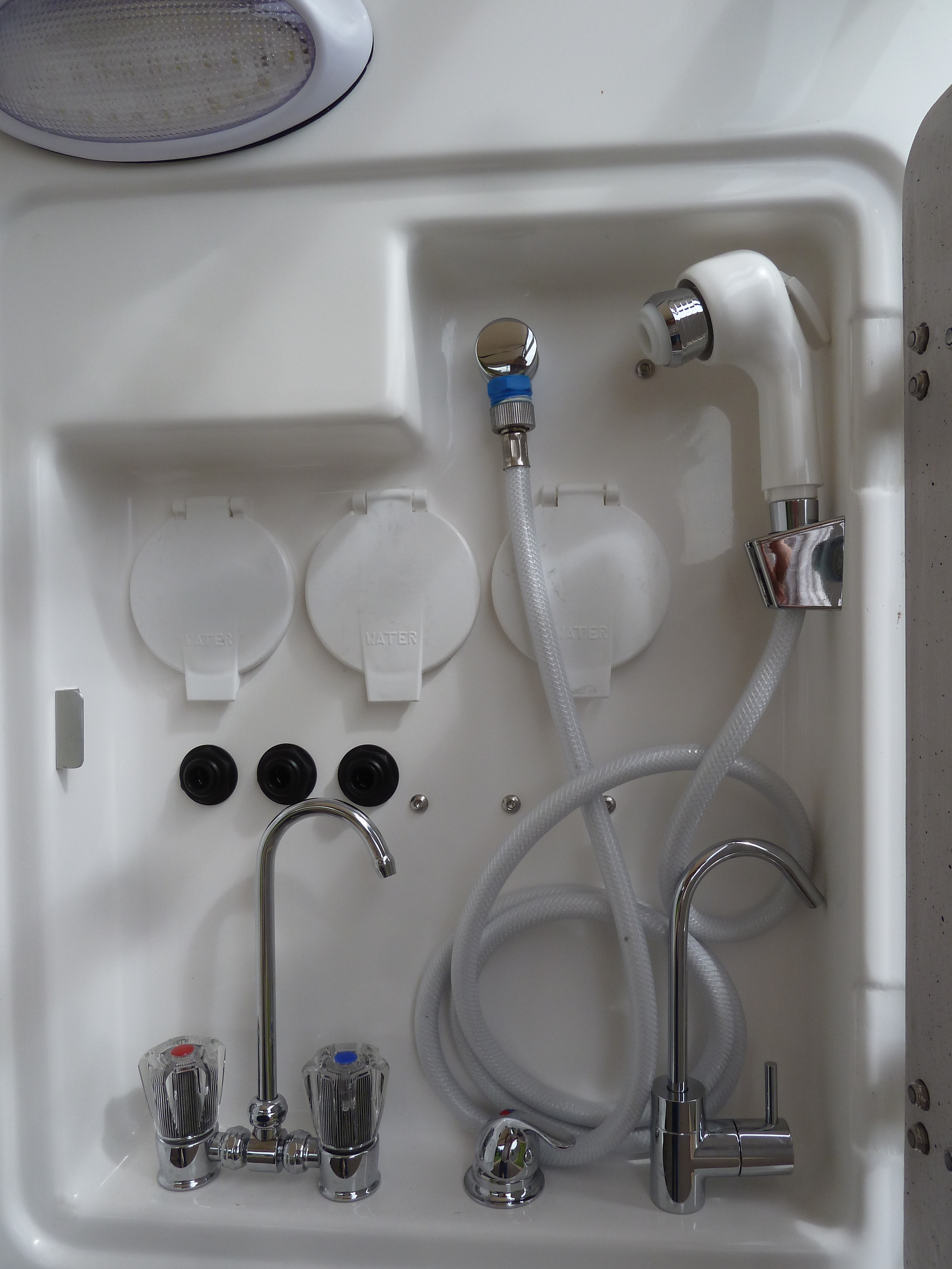
A33. Having the glass lid of the sink drainer unit in the down position inside the van, increases the available bench area.
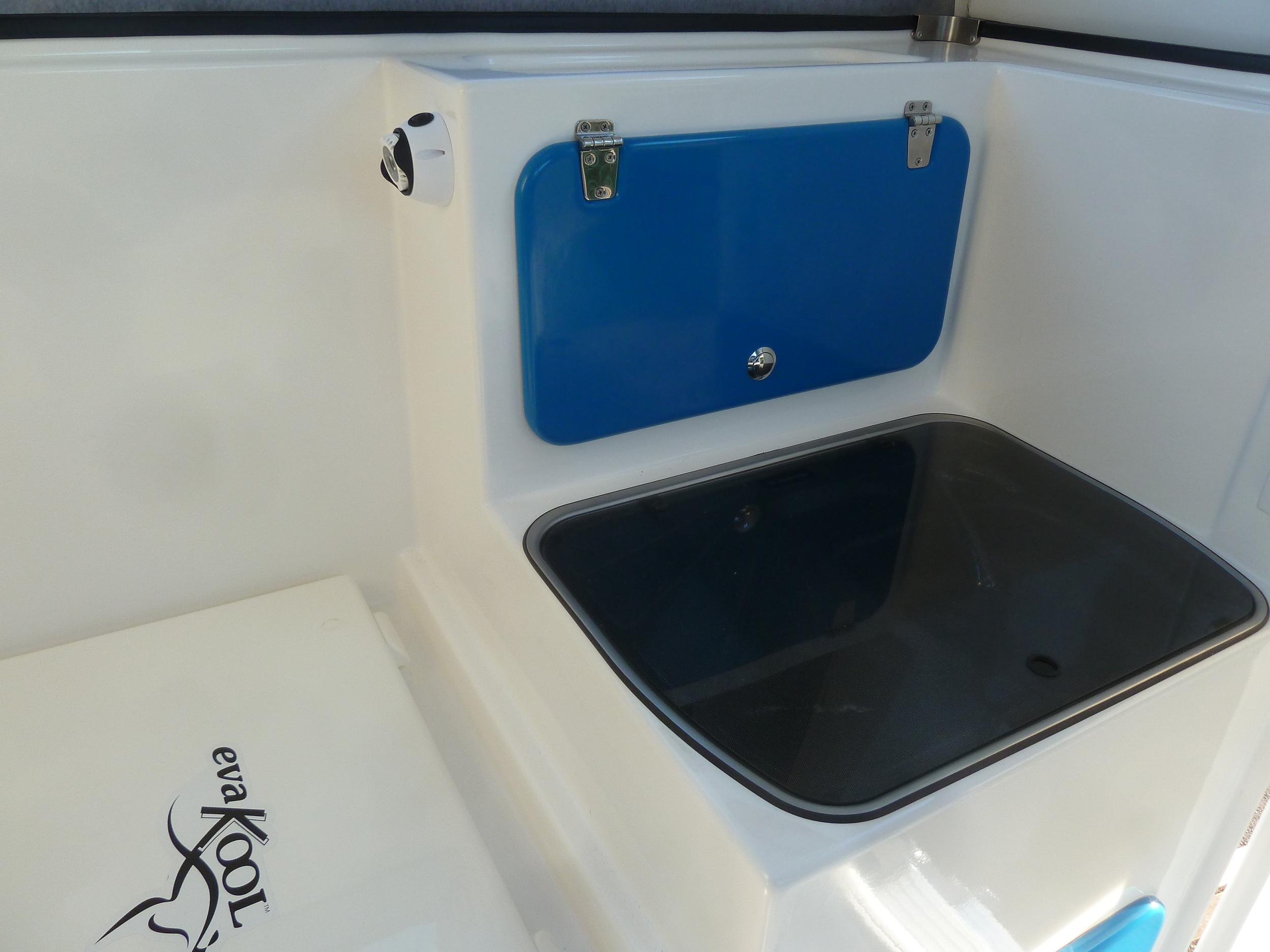
A34. “Walkertex” is a hard- wearing, attractive floor covering which can be easily removed from the van and hung over a clothesline and washed with a hose or a relatively high-pressure cleaner. Its rubber like backing prevents it from slipping on the floor and allows it to sit flat.
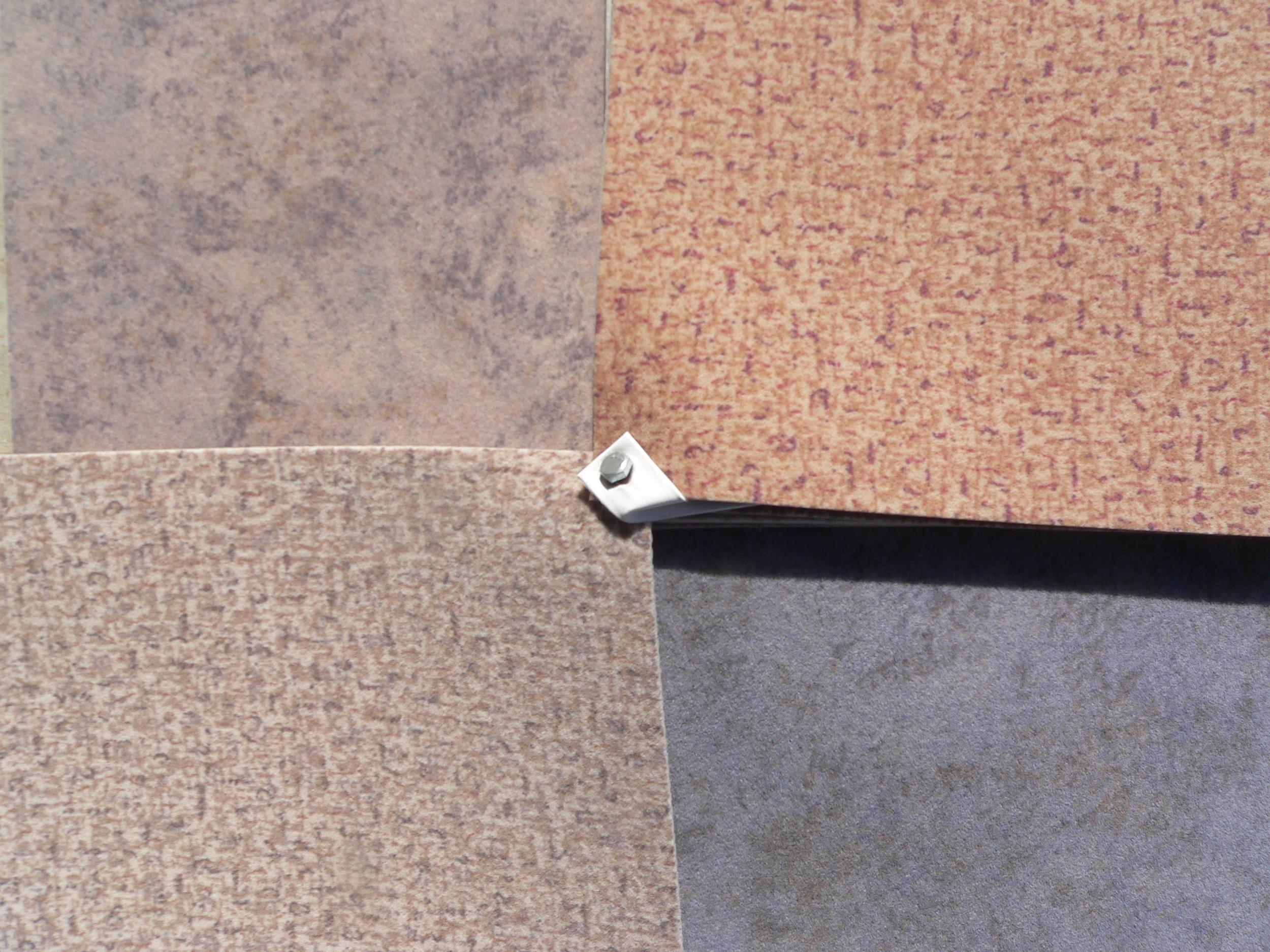
A35. All units are fitted with a fire extinguisher.

A36. In the photograph the white sections that are welded on to the jack stands, slide inside and lock into, the stainless steel 50mm x 50mm RHS tubes that are set into the fibreglass floor of the slide-on. These tubes are prevented from rotating by another RHS tube welded to them on the underside. This stainless steel part is used in the attachment of the slide on to the vehicle. It can also have a plate welded onto it which will locate the slide-on centrally over the tray.
Section B
B1.There is room in the gas storage compartment of the slide on for two, 4.5 kg gas bottles.

B2. Gas regulations require a vent near the floor when gas appliances are fitted internally. The vent in the back door satisfies this requirement.
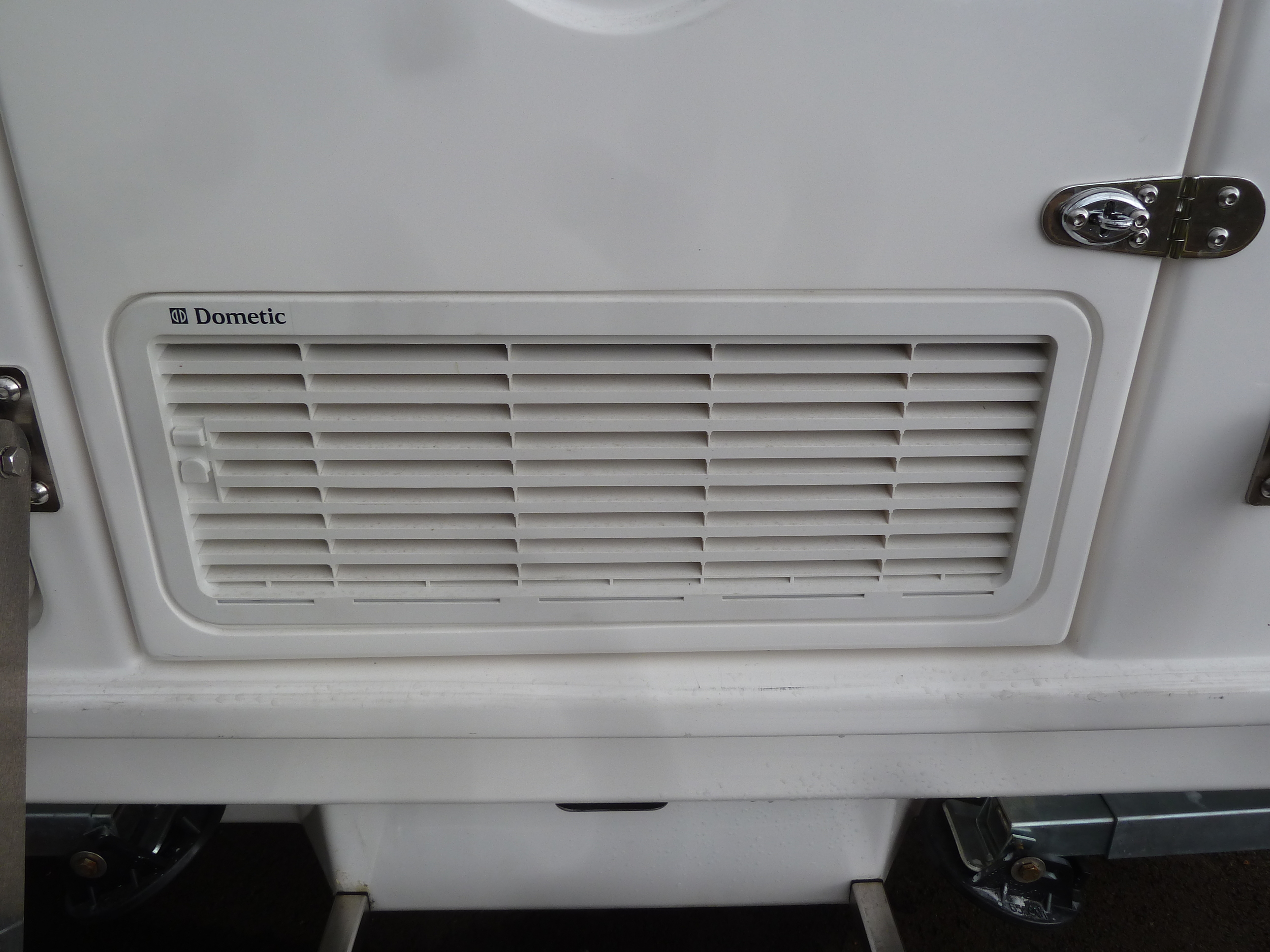
B3. Gas regulations also require a vent near or in the roof. The canopy hatch provides this ventilation and also allows light and some extra ventilation if required.

B4. The internal, three burner cook top has one burner large enough to cater for a large frypan, while still allowing plenty of room for a saucepan and kettle on the other two burners. It has electric ignition for all burners so it is a matter of turning and holding in the knob, while just touching a switch rather than pushing a Piezo plunger to ignite the gas.

B5. The gas hot water system is located on the driver’s side of the slide-on and is vented through the outside wall. The vent has a cover which prevents dust from entering the unit, but the cover must be removed to operate the hot water system. The ignition switch and the temperature control are located inside the caravan, on the front of one of the chest high cupboards. . Below right image reference - http://camec.com/truma-gas-elec-240v-14l-hws.html
B6.The external kitchen pulls out from a storage space on the left-hand side of the entry door. It is mounted on 200 kg drawer runners and when pulled out, folds out further with two more movements. When unfolded the outside bench section contains a stainless steel sink. Beside this section, there is a stainless steel workbench and at a higher level, there is an area with a two burner cook-top, a stainless steel storage well and room for a barbecue. The appliances are connected to the gas supply of the caravan with the use of a removable bayonet type fitting on the end of a gas hose. This is a requirement to satisfy gas regulations. When not in use, the main body of the kitchen unit can be slid back into the recess, leaving just the workbench and the sink protruding.
B7. Being a marine barbecue, this unit will work well in windy conditions and will supply plenty of heat. It is usually mounted on the pull out kitchen behind the cook top and is connected to the gas system in the van with a bayonet type fitting.
Below right image reference - http://www.sovereignbbqs.com/alpha_bravo.html
B8. The stainless steel Oven Wire insert replaces the grill plate to transform the barbecue so that it will operate more effectively as an oven.
Image reference - http://www.sovereignbbqs.com/PhotoGallery/bbq_accessories.html
B9. The Truma E 2400 gas air heater would connect to the gas supply of the caravan, but would need an extra gas line and would be vented to the exterior of the caravan. It would be quieter and cheaper than the diesel equivalent and would not have the fumes that are associated with a diesel heater. This unit is 123 mm high, 248 mm wide and 370 mm long. The Innovan XC caravan has excellent insulating characteristics and it would be only in very cold weather conditions that most people would find it necessary to use a heater. Below image reference - http://www.truma.com/au/en/heating/trumatic-e-2400.php

Section C
C1. More than half a metre of heavy duty wire protrudes from the front driver’s side corner of the slide on. Its purpose is to connect to another Anderson plug attached to the vehicle. This second Anderson plug is connected, hopefully with heavy wire, to the starting battery and possibly other auxiliary batteries, and to the alternator of the vehicle.
C2. The refrigerator/freezer units used by Innovan are built by EvaKool at Caloundra in Queensland using their normal components. However, the compressor and fan are located underneath the box rather than at the end. Instead of the Danfos BD 35 compressor, the Innovan units have the BD 50 compressor which is normally used in the larger EvaKool units. EvaKool offers a five-year warranty and on the one occasion so far, that there was an issue with a unit, the backup from EvaKool was outstanding. The unit has a movable divider in the box so that the relationship between the amount of freezing space and the amount of refrigerator can be varied. Items in the freezing compartment can be frozen solid while food items such as milk, tomatoes and lettuce are kept in good condition without freezing in the other compartment. Removal of the partition enables the whole box to act as either a refrigerator or a freezer, by adjusting the temperature setting. A client, who was fishing in the Northern Territory, reported having the whole box completely filled with fish fillets, to the extent that not another one could be added and that every fillet was frozen solid.
C3. With a slide on there is usually room to locate the battery or batteries under the tray of the vehicle or perhaps closer to the alternator. If it is intended to use the slide on when it is not attached to the vehicle then it would be preferable to have a battery inside the unit to operate the lights, the fridge and the pump etc.
Even though they are more expensive, Innovan uses AGM (absorbed glass mat) deep cycle batteries. Our experience and available data indicate that, when compared with the conventional lead acid battery, AGM batteries can better withstand the rigours of corrugated roads; they will last longer if treated as any battery should be treated; they can be charged faster; they can be discharged to a lower level without serious damage, and because they are sealed, they do not expel acid or explosive gas into the slide-on.

C4. If the intention is to stay in one place for an extended period of time and there is no means of charging the battery other than by using the alternator of the vehicle, then it might be worthwhile having a second battery. Cold conditions will also reduce the amount of energy available from a battery. Therefore, if you intend to spend a considerable amount of time in cold areas, it might be advisable to consider a second battery.
C5. A voltage booster is designed to ensure that the auxiliary battery can be fully charged, even if it is located a significant distance away from the starting battery. As described below, having the battery charged to 100% of its capacity could be expected to considerably increase the life of the battery. An isolating switch should be included in the wiring system between the starting battery for the vehicle and any battery/batteries that operate the 12 Volt appliances in the caravan (lights, fridge, pump, inverter and compressor). All the batteries need to be connected to the alternator to be charged, but when the alternator is not operating, then the starting battery needs to be disconnected from the other batteries, otherwise the current will be drained from it and the vehicle may not be able to be started.
The usual situation is that the alternator charges a starting battery located close to the alternator in the vehicle. Wires connect the starting battery (and the alternator) to an Anderson plug behind the cab of the vehicle. Another Anderson plug near the front driver’s side corner of the slide-on has wires running to the battery or batteries located in the slide- on. When the two Anderson plugs are joined together, the auxiliary battery is able to be charged if the alternator is operating.
There will be a drop in voltage as the current travels through the wire. The drop in voltage may be such that it is not sufficient to fully charge the battery. To compensate for the voltage drop in the wire from the alternator, a voltage booster located near the auxiliary battery can boost the voltage (electrical pressure) so that the battery can be charged to full capacity.
The CTEK D 250S Dual will boost the voltage, isolate the starting battery and also act as a regulator for solar panels. The below text and images have been referenced from (http://www.ctek.com/Archive/ProductPdf/D250S%20DUAL_EN.pdf)
The D250S DUAL charger obtains its energy from DC sources such as alternators, solar panels or wind power and optimises this power to meet the charging requirements of different battery banks. The D250S DUAL automatically selects the best connected DC energy source (of 2) for the purpose and switches between these energy sources to achieve high efficiency multi-stage charging. The D250S DUAL is particularly suitable for charging vehicles that do not have access to grid power supplies. Charging automatically starts as soon as DC energy is provided to the charger, for example, from alternators when a vehicle is started or from solar panels when connected. The D250S DUAL ensures that your batteries are always in good condition, quick charging and have long battery lifetimes.
The D250S DUAL is a fully automatic 5-stage charger that supplies 20 A to 12 V batteries of 40–300 Ah. The charger is IP65 classified water jet and dust protected and approved for outdoor use) and protects vehicle electronics. It is suitable for all types of lead-acid batteries (Wet, MF, Gel, AGM). It is supplied with a 2 year guarantee.
TECHNICAL DATA
CHARGING VOLTAGE 14.4 V
CHARGING CURRENT 20 A
TYPE OF CHARGER 5 step, fully automatic charging cycle
TYPE OF BATTERY 12 V lead-acid batteries
BATTERY CAPACITY 40–300 Ah
INSULATION IP65 (splash and dust proof)
FEATURES
- Multi-step charging from alternators and solar panels
- Battery separator that eliminates diodes and VSR relays
- Maintenance charge of starter battery
- Solar panel regulator with Maximum Power Point Tracking, synchronised with other current sources such as the alternator and/or wind
- Simplified installation of remote batteries for bow thrust of anchor winch
BENEFITS
- Maximised battery life due to minimised undercharge time
- Maximised battery capacity when the battery is kept fully charged avoiding harmful sulphate crystals on the lead plates and stratification of the battery acid.
- Ability to take charge automatically from any power source that is connected to the D250S DUAL
- Reduced charging times and costs by decreasing engine idling and the dependency on AC power onshore through efficient use of alternator and solar power
- Reduced environmental impact through extended battery life and a reduced idle time
- Minimal installation time and cost
FASTER CHARGING
The D250S Dual is a 5-step charger that automatically adjusts the charging voltage and current according to the battery state of charge and temperature–reducing a battery’s charge time.
A sensor on the CTEK charger senses the battery temperature and adjusts the required charge by increasing the voltage in cold weather ensuring the battery is fully charged, and dropping the voltage in hot weather to avoid the problems of overcharging.
With the D250S Dual , vehicle owners can be confident that their battery will always receive the optimal charging voltage, with reduced charge time and while ensuring the charging will be 100 % complete.
SOLAR CONNECTION
The D250S Dual has the additional benefit of an auxiliary input which can be connected directly to solar panels without the need for a regulator, offering free power from the sun.
D250S Dual has a built-in Maximum Power Point Tracker (MPPT) that helps the solar cells produce power as efficiently as possible by taking the most efficient source of energy from the solar panels automatically, and then using the power to charge the battery.
The MPPT searches for the most effective combination of solar cell voltage and current, ensuring that the solar and alternator function work in unison to maximise power output.
Modern vehicles with a “Smart Alternator” need to be wired as in the second diagram.
The table below indicates that if you never discharged a battery by more than 20% (that is below 80% of its capacity) you would expect to get about 3000 charging cycles for the life of the battery. It also shows that if you discharge it by using 40% of its capacity (that is you discharge it to 60% of its capacity) then you could expect half the battery life experienced with the previous situation.
Experts say that to fully charge an AGM battery more than 14 V is required. If the output of the alternator or other energy provider is inadequate, or there is sufficient voltage drop in the wiring so that the voltage at the battery is less than the 14 V, then the battery will not become fully charged. Suppose you did not want to discharge your battery below 80% of its capacity and the available means of charging could only charge the battery to 90% of its capacity. In this scenario, the electrical energy that you would have at your disposal, would only be half of what it would be, if the battery had been charged to 100% of its capacity.
Reference required...
C6. It is possible to have more than the three Cigarette sockets that are provided. There are also Merit, Engle and USB sockets available.
C7.An inverter will change 12 Volt direct current electricity into 240 Volt alternating current electricity. In other words, it changes the electricity that is normally supplied from the battery into the same sort of electricity that is found in an Australian home. You can plug into an inverter to charge a mobile phone with the same plug that you would use at home. There are inverters available with sufficient capacity to operate appliances with a high power requirement such as a microwave oven, but there is not sufficient energy available in one or two batteries to make this a viable proposition.
Appliances such as a 12V/240V TV or a laptop can be operated by plugging directly into a 12V supply using a particular cord designed for that particular appliance. Each cord has a transformer built into it to convert the 12 V DC current supplied by the battery to what is required for the particular appliance. As the appliances would already be designed to plug into a 240 V AC supply it is usually much cheaper to buy a small 12V – 240V inverter than to buy the special cord for each appliance.
On a SAFETY NOTE please remember that the inverter produces electricity at about 240 V and just like the 240 V mains supply, it can cause death.
An Inverter should NOT be left switched on when the vehicle supplying the 12 V current is being started. This is because the surge of current required to start a vehicle can drop the voltage down below 10 Volts. After the vehicle has started, and it can surge as high as 13.8 Volts and the combination of these 2 surges can damage the Inverter and/or appliance.
An 150 W inverter can be connected to the electricity supply with a cigarette lighter type plug but the higher capacity units need to be permanently wired with heavy cable to the battery.
Modified Square Wave (MSW) Inverter
Most appliances will work from Modified Square Wave (MSW) Inverters, but unfortunately unless you can look at the internal electronic design of the appliance, you can’t be sure if you will really need a "Pure" Sine wave Inverter. The squarish wave shape can also confuse the timing circuits in some appliances that use the Mains Frequency to control a clock. If the appliance doesn’t work normally or makes unusual noises, then disconnect it or you may have expensive damage. The MWS Inverters also generate more interference to TV and AM and HF radio reception than Sine wave Inverters and can cause buzzing in CD players.
Example image reference - http://caravansplus.com.au/catalog/product_info.php?products_id=13868
C8. Sine Wave Inverter (Please read the general notes in C7 first)
Sine Wave Inverters are more expensive than Modified Square Wave because more components are needed to electronically generate the Sine Wave. If the appliance has a Transformer or an Induction Motor, then it most probably needs a Sine Wave Inverter to prevent overheating. Computers are normally fine as they have Power Packs specifically made to limit fluctuations.
The manufacturer claims that the Victron Phoenix inverter pictured below is designed to output pure Sine Wave AC power which is perfect for sensitive electronics and so is suitable for the widest range of applications.
Reference image - http://www.victronenergy.net.au/
C9. There is a range of solar panel options that can be tailored to individual needs.
C10. The 240 V wiring circuit is completely separate from the 12 V wiring circuit. Power points in a caravan are required to be double-polled which makes them more expensive than those normally used in a house wiring circuit. In the Innovan slide on, the 240 V circuit has an external power inlet on the side of the unit to enable the connection of a flexible lead from some 240 V supply such as a caravan park power box, home power point or generator. The standard arrangement in the Innovan is that appliances can be plugged into a double power point inside the caravan in the front storage compartment under the table. There is an option to have an extra power point located on the left-hand side of the main entry door or possibly in some other location.
C11. The Air-conditioner unit suggested for use in the Innovan slide on is now the Truma Saphir Comfort with a remote control. It is sold by Dometic. The water tanks would need to be positioned beside each other and the air-conditioner would be mounted above them with room for air to pass through between the air-conditioner and the water tanks. The air from the living area would pass into and out of the air-conditioner through vents in the wall under the front of the table.
This arrangement would be much quieter than with an air-conditioner mounted on the roof. This unit is designed for caravans up to 6.5 m in length so would have abundant capacity to cater for the Innovan even with the extra headroom. Dometic offers 12 months’ warranty on parts and labour.
Reference images and feature list - http://www.truma.com/
Features:
- Extremely powerful, yet also very quiet
- The lightest in its class
- Convenient remote control
- Practical timer function for automatic switching on or off
- For vehicles up to approx. 6.5 m
C12. The CTEK MXS 7.0 replaces the multi-SX 7000. When connected to a 240 V AC supply it is capable of charging a variety of 12 V batteries. It features reverse polarity protection, non-sparking clamps and comes with CTX recondition mode to help revive heavily discharged or sulphated batteries. It also features the CTEK patented eight step fully automatic charging system that allows 100% charging of lead acid, gel, AGM, deep cycle, sealed and calcium batteries. It has an IP 65 rating for protection against dust and water. At the time of compiling these notes the MXS 7.0 is supplied with a five-year warranty
C13. Extra power points can be fitted in certain locations.
Image reference - http://www.ctek.com/int/en/chargers/MXS%207.0
Section D
D1. The Jack legs that Innovan is now using for the slide-on have a sliding section which can be pinned so that the height can be adjusted for a large range of tray heights. An L-shaped section is welded to the top of the jack leg and a nut on the outside end of the horizontal part of this L-shaped piece allows it to be wedged firmly into the stainless steel RHS section. The only movement in the leg is the minimal clearance for the sliding sections. The static load capacity of each leg is 1500 kg which provides a large margin for safety.


D2. The Innovan” Innoshield” awning system has been patented. Its special features are that it can be pulled out in a couple of seconds, it locks in position with the assistance of two gas struts and it is then ready for immediate use. In most weather conditions it does not need any extra support.
For cyclonic conditions, braces made from aluminium tube with end fittings can be attached from near the centre of the side arms to the bottom back corners of the van. For rainy conditions, a hoop can be inserted across the middle of the awning so that water does not collect.
D3. The sliding windows used in the Innovan XS are manufactured in Australia by CAMEC and have tinted safety glass, internal locking mechanisms and insect screens.
D4. The door to the toilet’s storage area is specially constructed so that when it is opened and the top edge rests on the floor, the toilet drawer lid, which supports the chemical toilet, can be rolled out to rest on the toilet storage door. This allows the weight of the toilet and a person to be fully supported, so that the drawer runners are not damaged when the toilet is being used.
D5. The top compartment of the toilet unit contains water for flushing and the bottom part has a very effective seal to prevent any odours escaping when the toilet is not being used. The toilet is located in an area where the refrigerator fan blows air around it and out through a vent to the exterior of the van when the Slide-on roof is raised.
The hold-down brackets are there to stop the toilet moving around while traversing rough terrain.
D6. In the Innovan the water filter is placed on the back wall in the area under the sink. The water that passes through it can be accessed with a dedicated tap in the vanity recess. If the option D7 is included, then water can be filtered on the way into the tank or on the way out, or both.
This particular filtration system has the superior characteristics of combining a 0.2 µ ceramic dirt and sediment pre-filter and a stack second stage CRPB 0.4 µ coconut carbon filter cartridge with a flow rate of up to 8 L per minute.
Filter cartridge life will depend on water quality and usage, but unlike most other caravan water filter systems available, the first stage ceramic filter can be taken out and cleaned with a Scotch-Brite cloth to restore the flow rate and extend the time between cartridge changes. The supplier states that the system will remove bad tastes and odours, chlorine, dirt and sediment, colours, rust, slime, algae, bacteria, E. coli, viruses, Giardia, Cryptosporidium, scale, salts, calcium, heavy metals (e.g. lead), pesticides, herbicides and more.
D7. The advantage of having this plumbing system is that water from an external source, such as a creek or a bucket, can be pumped into any one of the water tanks or used directly through the shower outlet. The system includes a number of taps to direct water flow. It also includes a plastic suction hose of sufficient length to reach the ground as well as a fitting which allows connection of a garden hose to the inlet side of the pump. It provides a facility for water supplied from a hose to be passed through the filter before going into the tanks.
Circumstances might arise when shower water can be heated by the Sun or a campfire and this plumbing system, with the help of a bucket, allows this heated water to be used in the shower. It simplifies filling a tank or tanks from a creek. It provides a safer method than that of using a bucket to obtain water from a water source which may contain dangers such as crocodiles.
D8. The vinyl shower cubicle is a purpose-built accessory that can be unfolded and hung under the awning. It is about 1800 mm high and has an opening on one side to fit against the vanity recess. A good quality zip is at one corner and across the bottom of one side to form a door which can be folded back under the awning. It has a fixed floor and a fitting which can be connected to a hose to drain water away. It provides privacy and protection from cold winds.
D9. The awning extension slides into a sail track fixed to the roof so that it can hang down to the ground over the three sides of the fold out awning. These can be pegged to the ground to make an enclosed area at the back of the slide on except for the area underneath the vehicle. The sides can be extended out horizontally and poles inserted at the edges with ropes pegged to the ground to hold the poles upright. One, two, or all three sides can be lifted up to form a shaded area.
D10. The inserts fill the space between the two beds so that the mattresses can be turned sideways and then pushed together to form a bed which is the width of a Queen-size bed. The mattresses would be 1880 mm long but when placed crossways there would be an extra 150 mm of length available, so with a pillow over the gap, the length available would be greater than that of a Queen bed.
D11. This bracket is designed so that the awning can be pulled in to a point where there is just sufficient room for the door to open and when the bracket is clamped to the arms of the awning, it holds it rigid and retains the strength of the awning. With a shortened awning there will be less buffeting of the van or flapping of the vinyl if strong, gusty winds were being experienced.
D12. The stainless steel spring support arm can be fitted to the storage compartment doors so that they are held in an open position as the spring coil becomes a rigid support. To close the door side pressure can be applied to the middle of the spring and the support will collapse allowing the door to be closed. This is particularly useful to keep the doors open in windy conditions or to prevent the doors from slamming against the face of the unit and bending the hinges.
D13. These window covers slide into a sail track fitted above the window. It is supported by aluminium struts and rubber straps.
D14. An insect screen with magnetic tape around the edge can be attached in the doorway to prevent entry of insects if the door is left open.
D15. Filter Replacements can be provided for your convenience, but are available elsewhere.
D16. There are a number of different off-the-shelf awnings available that could be mounted on the side of the roof underneath the window.
D17. Sail track could be mounted in a number of locations to suit individual requirements.
D18. The informed opinion seems to be that electrically connected rear vision cameras are much more satisfactory than radio controlled ones, so we offer the option of attaching one to the back of the van in the area under the door. The wires lead to a plug at the front of the caravan. The other half of the plug together with a 5 inch LCD monitor and wiring is supplied, so that the monitor can be fitted in a convenient location in the vehicle
Rear vision camera footage from a recent Cape York trip.
Section E
E1. The Linak LA36 actuators are arguably amongst the most advanced models from the world’s leading manufacturer of actuators. They have heavy-duty aluminium housing for harsh conditions and are protected against dust and water to the extent that they can be washed down with a high-pressure cleaner. They allow the roof to be raised or lowered using a toggle switch. A hand-held remote is available at extra cost.
Image reference: http://www.directindustry.com/prod/linak/electric-linear-actuators-solar-panels-7052-376361.html
E2. More water tanks could be installed in the slide on if the air-conditioner was not required.
E3. Having a hot water system operated by 240 V could be advantageous for people with a generator or if mains power was available.
E4. The Red Arc BCDC 1240 can produce 40 amps of current which would be useful to charge two batteries at the same time at a rate which is close to the maximum that would normally be desirable. It also has a built-in MPPT solar regulator for use with solar panels. The Multi Stage DC – DC Battery Charger can fully charge AGM, Gel, Calcium content, VRLA and standard Lead Acid batteries. It is also a Start Battery Isolator. It is fully sealed and super quiet when operating.
E5. The CTEK MXS 15 has the capacity to provide more than twice the current of the MX S7 and so should be able to charge a battery in half the time needed by the smaller unit.
The following summary and images have been extracted from: http://www.ctek.com/au/en
MXS 15 is a reliable power charger for 12V. It works just as well in the outback as in the city whether the situation requires quickly and safely charging a battery or long-term maintenance charging. The charger is as effective in workshops as on caravan or boat outings. Several chargers can be connected simultaneously if a higher charging current is required. It has functions that examine and show if the battery can be charged and maintain a charge, a special reconditioning function that restores stratified and deep discharged batteries, unique maintenance charging as well as a temperature sensor for optimised charging no matter the weather conditions. MXS 15 also has a feed function enabling the battery to be disconnected from the vehicle without loosing important settings.
MXS 15 is a completely automatic 8-step charger that gives 15A to 12V batteries between 40 and 300Ah. The charger has an IP 44 rating (outdoor use), protects vehicle electronics, produces no sparks and is polarity reversal and short circuit proof. It is supplied with a 2 year guarantee.
IP44. 230V. Capacity 40-300Ah. Charge current 15A. Dimensions 234x130x63 mm (LxWxH). Weight 1.9 kg. Suitable for all types of 12V lead-acid batteries (Wet, MF, AGM, Ca/Ca and GEL). Temperature range -20°C to +50°C.
E6. These Dometic windows are hinged at the top and have telescopic arms which allow easy opening and setting into various positions. Other features include robust quality with double acrylic borderless glazing, maximum security, ADR approval for use in recreational vehicles, a fine insect screen and a block out blind with a light grey interior and a reflective aluminium exterior.
These windows are larger than the sliding windows that are currently available. They differ from the sliding window in that the whole window area can be opened rather than just half and they will let in less rain if left open when it is raining. The downside is that they protrude from the side of the van by an extra 60 mm in a specially built housing.
Image reference: www.dometicrvcentre.com.au
E7. This door is an option for people who don’t want a toilet and the special supporting door and don’t want the slide out platform but would still like access to this area from inside the van.
E8. Some people might prefer a larger screen.













